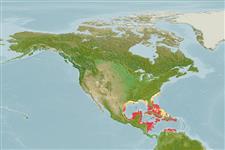Common names from other countries
Elasmobranchii (hajar och rockor) (sharks and rays) >
Myliobatiformes (Stingrays) >
Urotrygonidae (American round stingrays)
Etymology: Urobatis: Greek,oura = tail + Greek, batis, batidos = a ray (Raja sp.) (Ref. 45335).
More on author: Cuvier.
Environment: milieu / climate zone / depth range / distribution range
Ekologi
marina revassocierade; djupintervall 1 - 25 m (Ref. 9710). Tropical; 37°N - 7°N, 100°W - 59°W (Ref. 55316)
Western Atlantic: North Carolina, USA to northern South America. Also in Bahamas, Yucatan and throughout Caribbean (Ref. 26938).
Size / Vikt / Age
Maturity: Lm ? range ? - ? cm
Max length : 76.0 cm TL hane/ej könsbestämd; (Ref. 9710)
Edge of disk no sharp angles, no dorsal fin. Well-developed caudal fin extends around tip of tail, doubly serrate spine near caudal fin base (Ref. 26938). Disk yellowish, with dark vermiculations and spots that form a variety of patterns on upper surface (Ref. 7251). Lower surface is yellowish, greenish or brownish white, tail with dark spots (Ref.6902).
Commonly found along sandy beaches to the water's edge, and especially in sandy areas in and around coral reefs (Ref. 7251). Raises front end of disc to attract prey seeking shelter (Ref. 7251). Feeds on shrimps, probably also on small fishes, clams, and worms (Ref. 12951). Known to be capable of inflicting dangerous wounds with its venomous spine. Easily approached (Ref. 9710). A live-bearing species, produces 3 to 4 young (Ref. 26938).
Life cycle and mating behavior
Maturities | Reproduktion | Spawnings | Egg(s) | Fecundities | Larver
Male grasps disc margin of female, swings under her and inserts a clasper. Mating pair is surrounded by other males that swim around and nudge them. Dugger (1987) (Ref. 51118) observed both male and female biting the pectoral fin of its mate (Ref. 49562).
Compagno, L.J.V., 1999. Checklist of living elasmobranchs. p. 471-498. In W.C. Hamlett (ed.) Sharks, skates, and rays: the biology of elasmobranch fishes. Johns Hopkins University Press, Maryland. (Ref. 35766)
IUCN Red List Status (Ref. 130435)
CITES (Ref. 128078)
Not Evaluated
Threat to humans
Venomous
Human uses
Fiskeri: kommersiell; Akvarium: Offentliga akvarier
Verktyg
Special reports
Download XML
Internet-källor
Estimates based on models
Preferred temperature (Ref.
115969): 25.8 - 28.1, mean 27.3 (based on 482 cells).
Phylogenetic diversity index (Ref.
82804): PD
50 = 0.5078 [Uniqueness, from 0.5 = low to 2.0 = high].
Bayesian length-weight: a=0.01072 (0.00570 - 0.02016), b=3.03 (2.86 - 3.20), in cm Total Length, based on LWR estimates for this species & (Sub)family-body (Ref.
93245).
Trofisk nivå (Ref.
69278): 3.6 ±0.51 se; based on food items.
Resiliens (Ref.
120179): Mycket låg, lägsta populationsfördubblingstid mer än 14 år (Preliminary K or Fecundity.).
Fishing Vulnerability (Ref.
59153): Moderate to high vulnerability (50 of 100).
